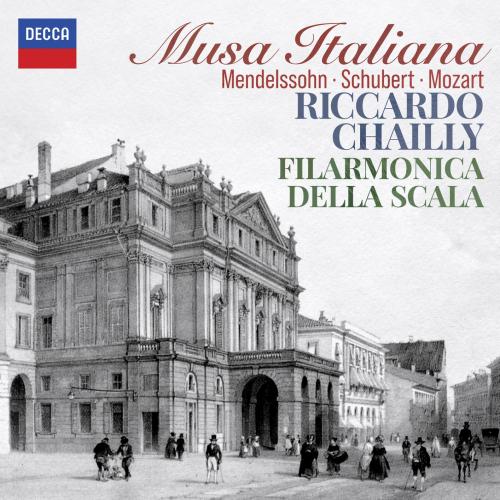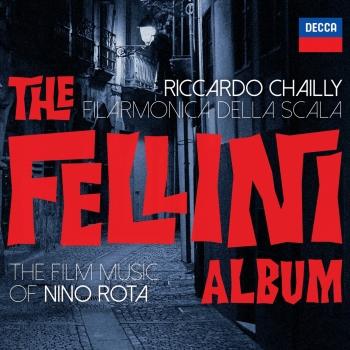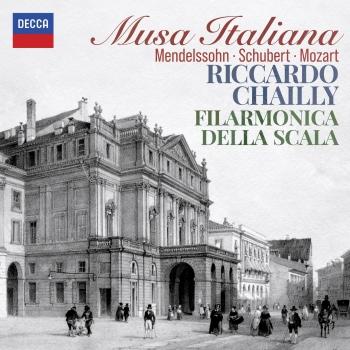
Musa Italiana Filarmonica Della Scala & Riccardo Chailly
Album info
Album-Release:
2022
HRA-Release:
20.05.2022
Label: Decca Music Group Ltd.
Genre: Classical
Subgenre: Orchestral
Artist: Filarmonica Della Scala & Riccardo Chailly
Composer: Felix Mendelssohn (1809-1847), Wolfgang Amadeus Mozart (1756-1791), Franz Peter Schubert (1797-1828)
Album including Album cover
I`m sorry!
Dear HIGHRESAUDIO Visitor,
due to territorial constraints and also different releases dates in each country you currently can`t purchase this album. We are updating our release dates twice a week. So, please feel free to check from time-to-time, if the album is available for your country.
We suggest, that you bookmark the album and use our Short List function.
Thank you for your understanding and patience.
Yours sincerely, HIGHRESAUDIO
- Felix Mendelssohn (1809 - 1847): Symphony No. 4 in A Major, Op. 90, MWV N 16, "Italian" (Ed. John Michael Cooper):
- 1 Mendelssohn: Symphony No. 4 in A Major, Op. 90, MWV N 16, "Italian": I. Allegro vivace 10:01
- 2 Mendelssohn: Symphony No. 4 in A Major, Op. 90, MWV N 16, "Italian": II. Andante con moto 06:17
- 3 Mendelssohn: Symphony No. 4 in A Major, Op. 90, MWV N 16, "Italian": III. Menuetto. Con moto moderato 07:28
- 4 Mendelssohn: Symphony No. 4 in A Major, Op. 90, MWV N 16, "Italian": IV. Saltarello. Presto 06:32
- Franz Schubert (1797 - 1828): Overture in the Italian Style in D Major:
- 5 Schubert: Overture in the Italian Style in D Major, D. 590 08:18
- 6 Schubert: Overture in the Italian Style in C Major, D. 591 08:05
- Wolfgang Amadeus Mozart (1756 - 1791): Mitridate, rè di Ponto, K. 87/74a:
- 7 Mozart: Mitridate, rè di Ponto, K. 87/74a: Overture 05:54
- Ascanio in Alba, K. 111:
- 8 Mozart: Ascanio in Alba, K. 111: Overture 03:38
- Lucio Silla, K. 135:
- 9 Mozart: Lucio Silla, K. 135: Overture 07:49
Info for Musa Italiana
Decca Classics presents the new album by Riccardo Chailly conducting the Filarmonica della Scala. Due for release on 20 May, 'Musa Italiana' celebrates the influence of Italian style on three Austro-German composers: Wolfgang Amadeus Mozart, Franz Schubert and Felix Mendelssohn. Recorded in Dolby Atmos at La Scala during the pandemic, this album enhances the theatre's famous acoustics in a unique way. As Chailly explains: 'Because of the pandemic and the need for more space between the orchestral professors, a new floor was created above the stalls seats... And it says a lot about the genius of Giuseppe Piermarini, the architect of La Scala, because, right in the middle of the theatre, the acoustics are spectacular. The acoustics at La Scala tend to be dry to support the voices, but outside the stage the sound is wonderful'.
Felix Mendelssohn's 'Italian Symphony' (No. 4 in A major) was composed during a 10-month Grand Tour of Italy between 1829 and 1831 when the composer was in his early twenties. It draws inspiration from the natural beauty, culture and music of our country, particularly in the saltarello rhythms used to great effect in the final tarantella. Chailly recorded the revision of Mendelssohn's 1834 opera, which he believes enhances the dramatic character of the work. 'The finale,' Chailly observes, 'is a tarantella in which, when you are bitten by a tarantula, you have to dance or die... These are moments of great drama in an opera where joy and beauty are celebrated'.
By the late 1810s Gioachino Rossini's musical innovations had conquered Vienna and clearly had a profound effect on Franz Schubert. His two Overtures in Stile Italiano pay homage to Rossini, with the Overture in D major quoting the opera 'Tancredi' and the Overture in C major featuring a version of Rossini's famous 'crescendo'.
The young Wolfgang Amadeus Mozart's visits to Italy proved decisive for his musical education. The three overtures for 'Mitridate', 'Ascanio in Alba' and 'Lucio Silla' included in this album were all originally premiered in Milan. As Chailly says: 'I think they are part, whether you like it or not, of the La Scala tradition, and the orchestra plays them with such conviction and dedication, because they are difficult pieces to interpret'.
Filarmonica della Scala
Riccardo Chailly,
Filarmonica della Scala
was first set up by Claudio Abbado and the musicians of La Scala Opera House in 1982 with the aim of developing a symphonic repertoire. Carlo Maria Giulini conducted the Orchestra in more than 90 concerts. Riccardo Muti became the Principal Conductor from 1987 to 2005.
From November 2015 Riccardo Chailly is Filarmonica della Scala’s Principal Conductor. The Orchestra has collaborated with some of the greatest conductors of the time: Georges Prêtre, Lorin Maazel, Wolfgang Sawallisch, Zubin Metha, Leonard Bernstein and many others. From 2006 Filarmonica has intensified its relation with Daniel Barenboim, Riccardo Chailly, Daniel Harding, Daniele Gatti and Valery Gergiev.
From 2013 Filarmonica hosts the Concerto per Milano in Piazza Duomo, an acclaimed event which has made more than 40.000 people attendance every year. A project, addressed specifically to primary school children, is the Sound, Music! initiative.
Filarmonica also has a long tradition in supporting Milan’s main scientific institutions and voluntary bodies, through special concerts for their benefit and open rehearsals belonging to the series Prove Aperte.
Filarmonica has a particular interest in contemporary music from the beginning, every season features a new commission to an important composer of our time.
Filarmonica performed more than 600 concerts on tour in the last 30 years. Important milestones have included the Orchestra’s debut in the United States with Riccardo Chailly and in China with Myung- Whun Chung.
Filarmonica has made numerous recordings for music labels such as the album Viva Verdi for Decca with Riccardo Chailly and, for Sony, the project 900 Italiano that by now counts 3 DVDs directed by Georges Prêtre, Fabio Luisi and Gianandrea Noseda.
Filarmonica della Scala’s activity is supported by the Main Partner UniCredit.
This album contains no booklet.











